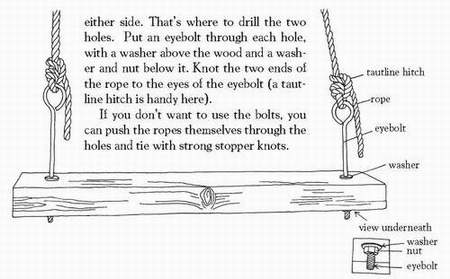Tree Swing

WHAT YOU NEED
♦ Wood, 2 × 8, 2 ″ long
♦ Rope
♦ Two eyebolts, 8″ long, with a 3/8/3/8″ thread, two nuts and four washers
♦ A tennis ball, a sock, and some twine
♦ Drill with 3/8/3/8″ bit
THE HARDEST PART of building a tree swing is finding a well-suited branch. We can tell you that a tree-swing branch should be at least 8 inches in diameter, but on a tree tall enough for a swing, that can be difficult to measure precisely. You’ll also need a strong rope long enough to get around the branch and down to the ground and back up again.
Your swing should not be on a white birch, because those rubbery branches readily bend. Look for a hardy oak or maple. The spot on the branch where you hang your swing should be far enough from the trunk so no one is hurt when they swing, but close enough so the branch is still strong.
The second hardest part is getting the rope up and over the branch. To forestall several hours of standing with a rope and squinting into the sun, we have a strategy to suggest:
Put a tennis ball in an old sock. Wrap twine around the sock and make a knot so the tennis ball stays put, and make sure you have enough twine on the skein so it can unfurl the length up to the tree branch, and back down again.
Stand under the tree and aim the tennis-ball-in-the-sock over the branch. It may take a few tries, but it is much easier than just flinging the rope up to the branch.
Once up-and-over, the tennis ball sock will land near your feet, trailed by a long strand of twine. Knot the twine to the rope to be used in the tree swing. (Try a sheetbend knot, it’s designed to join different sized-ropes.) Pull the twine until the rope is over the branch. You might want to toss the ball/rope combo over again, to double-loop the rope over the branch. When all is in place, detach the twine. The rope is set.
The easiest part is making the seat and procuring a long length of knot. Find or cut a 2-foot long piece of 2-by-8 wood. Draw a line down the center, lengthwise, and measure 2 inches in from either side. That’s where to drill the two holes. Put an eyebolt through each hole, with a washer above the wood and a washer and nut below it. Knot the two ends of the rope to the eyes of the eyebolt (a tautline hitch is handy here).
If you don’t want to use the bolts, you can push the ropes themselves through the holes and tie with strong stopper knots.
